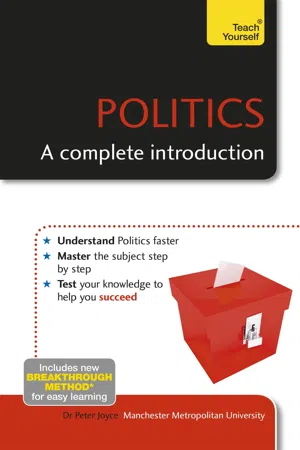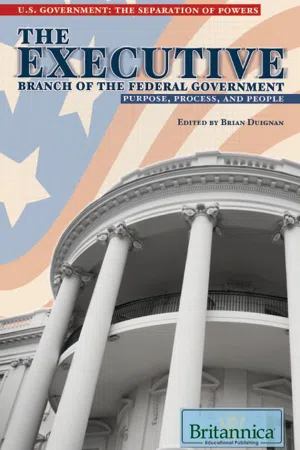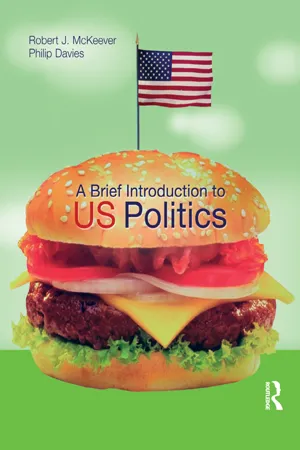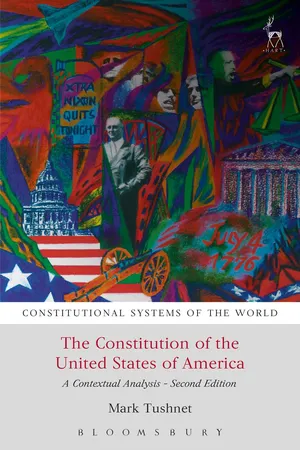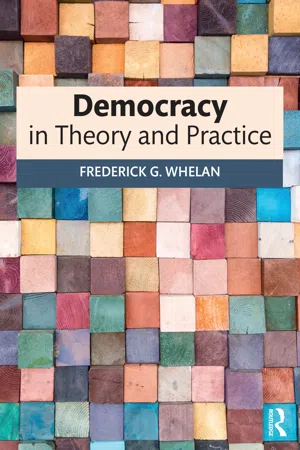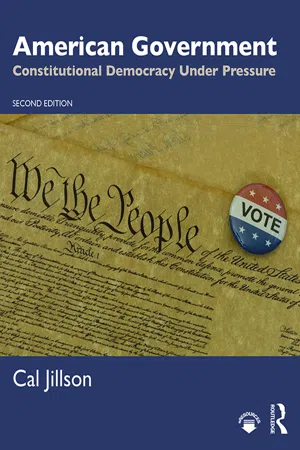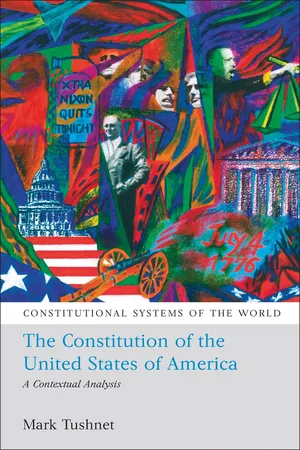Politics & International Relations
The Executive Branch
The Executive Branch is one of the three branches of government, responsible for implementing and enforcing laws. It is headed by the president or prime minister and includes various departments and agencies that carry out the day-to-day operations of the government. The Executive Branch also plays a key role in foreign policy and diplomacy.
Written by Perlego with AI-assistance
Related key terms
Related key terms
1 of 4
Related key terms
1 of 3
8 Key excerpts on "The Executive Branch"
- Peter Joyce(Author)
- 2015(Publication Date)
- Teach Yourself(Publisher)
10 The Executive Branch of governmentThe role of The Executive Branch of governmentThe Executive Branch of government exerts political control over a nation’s political affairs and is responsible for implementing laws. It is headed by the country’s most senior politician who serves as the nation’s chief executive. In this chapter we will consider the functions that are performed by The Executive Branch of government, the specific role that is carried out by chief executives, and the key features of presidential and cabinet government.Key idea (1) The Executive Branch of government consists of politicians and permanent officials who are responsible for implementing decisions relating to the conduct of a nation’s internal and external political affairs.The work of The Executive Branch of government is performed by two distinct sets of people: politicians, and paid, permanent officials. We will consider the workings of the latter, termed ‘bureaucracy’, in Chapter 13 and the discussion in this chapter will concentrate on the role performed by politicians who give leadership to The Executive Branch of government and who are usually referred to as ‘the government’. For example, in the UK, the government consists of the prime minister, cabinet, and junior ministers. In America it is composed of the president and the cabinet.Parliamentary and presidential political structures
A basic division exists within liberal democracies between parliamentary and presidential forms of government. Within liberal democracies, governments tend to be either parliamentary or presidential.Key idea (2) In a parliamentary system of government, The Executive Branch of government is drawn from the legislature and is also collectively accountable to this body for its actions. The office of head of state is separate from the chief executive, the latter being the leader of the largest political party (or coalition of parties) commanding support in the legislature who is called upon by the head of state to form a government. The tenure of chief executives in office is dependent on retaining the legislature’s support, and chief executives typically possess the ability to recommend the dissolution of the legislature to the head of state, which triggers a general election. Countries which have this form of government include the UK and Germany.- eBook - ePub
- Lori Cox Han(Author)
- 2021(Publication Date)
- Greenwood(Publisher)
6 The President and The Executive BranchThe job of president includes many roles, both constitutional and ceremonial. In addition to serving as commander in chief of the nation’s military, the president is also both head of state and head of government. The former is mostly ceremonial in that presidents, for example, represent the United States on the world stage. The latter refers to the fact that the president is the chief executive of the federal government. What does it mean to be the chief executive? Some compare it to being the chief executive officer of a large corporation. In some respects, the comparison is understandable, even though the jobs are vastly different in size and scope. In American political life, the president is held responsible for the operation of the government, and if the government fails to meet popular expectations, the president takes the blame. The president has many responsibilities in this role, and many factors can affect his performance.This chapter considers the constitutional and political implications of the president’s relationship with The Executive Branch of government. The federal government employs more than three million people, and nearly all are found within the complicated bureaucratic structure of agencies within The Executive Branch. Therefore, organization is crucial in understanding how the bureaucracy works and how the president manages the day-to-day operation of the federal government.The Executive Office of the President (EOP), created in 1939 to help the president manage this responsibility, has evolved into a highly specialized and compartmentalized bureaucracy. The EOP carries out such institutionalized staff functions as program planning and review, budgeting, implementation, and evaluation. Within that structure is the Cabinet and White House staff, who are part of the president’s team regarding both policy and political matters. Throughout American history, vice presidents and first ladies have also played an important role in how the president governs. - eBook - ePub
The Executive Branch of the Federal Government
Purpose, Process, and People
- Britannica Educational Publishing, Brian Duignan(Authors)
- 2009(Publication Date)
- Britannica Educational Publishing(Publisher)
An important feature of constitutional government is that the functions assigned to the different branches ensure that political power is shared among them. In the U.S. system, for example, the different branches share some of the same powers insofar as each branch is able to prevent certain actions by the others—e.g., the president (the chief executive) may veto, or reject, legislation passed by Congress, the legislative branch of the federal government; the Senate (one of the two chambers of Congress, the other being the House of Representatives) may reject treaties and certain appointments made by the president; and the courts may invalidate laws passed by Congress or certain acts by the president or by executive agencies. In parliamentary forms of government such as that of the United Kingdom, power is shared through an even greater integration of the functions and even the personnel of the executive and the legislature. In the nonconstitutional systems of totalitarian or dictatorial countries, in contrast, although there may be separate institutions such as legislatures, executives, and judiciaries, power is not shared but rather concentrated in a single institution. Because this body is not subject to the checks of shared power, the exercise of political power is uncontrolled or absolute.THE POLITICAL EXECUTIVE
Political executives are government officials who participate in the formulation and direction of government policy. They include not only heads of state and government leaders—presidents, prime ministers, premiers, chancellors, and other chief executives—but also many secondary figures, such as cabinet members and ministers, councillors, and agency heads. In the United States and other large industrialized countries there are several thousand political executives, including the president, dozens of political appointees in the cabinet departments, in the agencies, in the commissions, and in the White House staff, and hundreds of senior civil servants.The crucial element in the organization of a national executive is the role assigned to the chief executive. In presidential systems, such as in the United States, the president is both the political head of the government and also the ceremonial head of state. In parliamentary systems, such as that of the United Kingdom, the prime minister is the national political leader, but another figure, a monarch or elected president, serves as the head of state. In mixed presidential–parliamentary systems, such as that established in France under the Fifth Republic’s constitution of 1958, the president serves as head of state but also wields important political powers, including the appointment of a prime minister and cabinet to serve as the government.The manner in which the chief executive is elected or selected is often decisive in shaping his role in the political system. Thus, although he receives his seals of office from the monarch, the effective election of a British prime minister usually occurs in a private conclave of the leading members of his party in Parliament. Elected to Parliament from only one of nearly 650 constituencies, he is tied to the fortunes of the legislative majority that he leads. In contrast, the American president is elected by a nationwide electorate, and, although he leads his party’s ticket, his fortunes are independent of his party. Even when the opposition party controls the Congress, his fixed term and his independent base of power allow him considerable freedom to manoeuvre. These contrasts explain many of the differences in the roles of the two chief executives. The British prime minister invariably has served for many years in Parliament and has developed skills in debate and in political negotiation. His major political tasks are the designation of the other members of the cabinet, the direction of parliamentary strategy, and the retention of the loyalty of a substantial majority of his legislative party. The presidential chief executive, on the other hand, often lacks prior legislative and even national-governmental experience, and his main concern is with the cultivation of a majority in the electorate through the leadership of public opinion. Of course, since the president must have a legislative program and often cannot depend on the support of a congressional majority, he may also need the skills of a legislative strategist and negotiator. - eBook - ePub
- Robert J. Mckeever(Author)
- 2014(Publication Date)
- Routledge(Publisher)
Chapter 6 The presidency and The Executive BranchThe presidency of the United States is often referred to as the most powerful office in the world. In truth the executive is but one branch in American constitutional government, and the presidents who occupy the leading office in this branch face considerable complications in turning their executive agenda into deliverable policy. The Constitution provides the president with the tools of office, and the office-holders use these tools with differing skills, and in differing contexts. The office has certainly taken a central role in national and international perceptions of American government, and this perception itself adds to the authority that it has gained over the centuries. The president still faces a complex situation, having at all times to negotiate major initiatives with the members of the US Congress.The Executive Branch of the federal government includes a vast array of experts organised into departments and agencies. Their purpose is to serve the government, and especially the president, by providing specialist knowledge to policy-makers and by administering national laws and policies. The Executive Branch of the United States government employs almost 2.7 million men and women, that is, approximately one in fifty of all Americans in work (Statistical Abstract of the United States, 2004–5). This is a remarkable number of government employees for a nation which prides itself on its individualism and its belief in limited government. Nevertheless, the phenomenal growth in the size and range of the federal bureaucracy is no aberration. Rather, it has been a logical response to the increasing complexity of American society and the unrelenting growth in federal government responsibilities.The constitutional debateThe members of the US Constitutional Convention debated long and hard about the form that the nation’s executive should take. There was little enthusiasm for a system that might replace George III with a home-grown executive that might prove equally threatening, but there were concerns that the new nation should have an executive leadership capable of acting decisively in the nation’s interest when necessary. Thomas Cronin (1989) points out that at least sixty votes were taken by the authors of the US Constitution on the method of election of the executive, eligibility to hold the office, and the length and number of terms of office. - eBook - ePub
The Constitution of the United States of America
A Contextual Analysis
- Mark Tushnet(Author)
- 2015(Publication Date)
- Hart Publishing(Publisher)
3The Constitutional Politics of The Executive Branch
The President as Party Leader – The President’s Role in Legislation – The Unitary Executive and the Modern Administrative State – The Unitary Executive in Foreign Affairs – ConclusionTHE CONSTITUTION’S FRAMERS believed that Congress would be the predominant institution in the national government. The president, they believed, would serve primarily as an executive or manager of the programs Congress adopted. This expectation is captured in the fact that Congress is the subject of the Constitution’s first Article, consisting of 10 sections and about 2,250 words, the president the subject of Article II, with four sections and 1,000 words. Popular terminology reflects this expectation as well: Americans use the term ‘the government’ to mean Congress in the first instance and the combination of Congress and The Executive Branch secondarily, and use the term ‘the administration’ where people accustomed to parliamentary government would use the term ‘the government’.The president was not to be a mere figurehead, though. In the checks-and-balances system the Constitution created, the president was given a source of political authority—and power—different from the sources of authority and power for the houses of Congress. The president was also given some power to influence legislation directly, by recommending that Congress adopt laws and, more important, by vetoing laws Congress adopted. (Yet, indicating the assumption that Congress was the primary actor in the constitutional system, the president’s veto power was limited, not substantively but procedurally, by the ability of Congress to make its laws effective despite the president’s disapproval, if they could muster a two-thirds majority in both houses to override the veto.) These political and constitutional resources, the framers believed, would create a government that had enough power to accomplish the nation’s purposes but not so powerful as to engage in imprudent ventures or threaten the rights of the nation’s citizens. - eBook - ePub
- Frederick G. Whelan(Author)
- 2018(Publication Date)
- Routledge(Publisher)
14 The chief of a victorious parliamentary party who becomes prime minister holds a similar position, especially if his or her party wins a majority of seats. Hence the meaning of “executive,” especially in the case of the chief executive as a political leader, goes well beyond the meaning of the term in the classical separation-of-powers theory. In that theory, the active or directing power of the state was assumed to be vested in the legislature, which passed laws which the executive merely carried out: the job of a minister, by the same token, was merely to administer, and that of a president merely to preside over the executive apparatus. Partly because of its combination of roles, and partly because it is vested in the final analysis in a single individual, the executive power of a modern state is normally in practice its directive power, hence a suitable location for a leader to apply his distinctive skills.Foreign policy, including military and national security affairs, is one important domain where policy is largely made, not just executed, by the chief executive, aided and sometimes guided by the subordinate foreign and defense ministers and the staffs of their departments.In the original Hamiltonian conception of the executive power in the US Constitution, the emphasis was on the need for energy, decisiveness, speed, and unity in the president’s exercise of the authority of the state. These are qualities that have a special bearing on foreign affairs, where situations requiring decisions can arise rapidly and unexpectedly.(Federalist no. 70)ALEXANDER HAMILTON Box 17.1Alexander Hamilton (1755–1804) was an American revolutionary, delegate to the Constitutional Convention, principal author ofThe Federalist, and first Secretary of the Treasury. He advocated a strong national government with the federal structure and a strong or “energetic” president in the federal government. - eBook - ePub
American Government
Constitutional Democracy Under Pressure
- Cal Jillson(Author)
- 2020(Publication Date)
- Routledge(Publisher)
Chapter 9The Executive Branch
The President, the Bureaucracy, and Executive Power
Focus Questions and Learning GoalsQ1 How did the Founders limit the powers that they placed with the president?Q2 What forces account for the growth of executive power over the course of American political history?Q3 Why does the president have an easier time in shaping and implementing foreign policy than he does domestic policy?Q4 How does the president relate to The Executive Branch?Q5 Should we be concerned that White House staff members have replaced members of the cabinet as the president’s closest advisers?The Unitary Executive Theory of Presidential Authority
Article II, section 1: “The executive power shall be vested in a President of the United States of America.”While the constitutional origins of presidential authority are clear, centering on the clause above, the scope and limits of that authority are hotly contested. Scholars have long noted that while the powers explicitly enumerated in the Constitution’s Article II are few—commander in chief, pardon power, and, with the advice and consent of the Senate, broad appointment powers—the president has additional unenumerated powers.unitary executive theory Strong presidency theory holding that the president embodies executive authority and is the sole judge, particularly in wartime, of what is required to protect the nation and its people.Moreover, students of executive power all the way back to John Locke (1632–1704) have argued that kings and presidents may have to act outside the law or even in contravention of the law when great dangers threaten. The “inherent powers” of the executive, they argue, may require bold action, even action that would be illegal under normal circumstances, to confront dire threats. Officials of the George W. Bush administration argued for an even broader “unitary executive” theory of presidential authority. The unitary executive theory - eBook - ePub
The Constitution of the United States of America
A Contextual Analysis
- Mark Tushnet(Author)
- 2008(Publication Date)
- Hart Publishing(Publisher)
Presidents regularly criticize Congress for disregarding their budget submissions and for adding unnecessary expenditures of primary local benefit, referring to such provisions as ‘pork’, excess fat on the president’s lean budget. Members of Congress respond that the projects do indeed serve important public purposes that they, closer than the president to their communities, understand better. Recently presidents have criticized members of Congress as well for ‘earmarks’ in the budget. Here is how earmarks work: Congress creates some general program, for example for funding scientific research, and appropriates a specified amount to be awarded by an executive branch agency based on the agency’s evaluation of the merits of proposals submitted to it. An earmark designates a specific project, for example for research at the University of Northern Iowa into conversion of corn into ethanol, to receive funding without going through the agency’s evaluation process. Presidents criticize earmarks for increasing government expenditures, but it is unclear exactly why they do. The real effect of earmarks is to transfer the power to identify projects for funding from The Executive Branch agency to Congress itself. Earmarking is thus part of the struggle between Congress and the president over substantive policy, not over the size of the budget. The constitutional politics of the budget are no different from the constitutional politics of other matters.Conclusion
Even as the iron triangles lost their tight grip on the way in which executive bureaucracies worked in the late twentieth century, presidents continued to face obstacles caused by the accumulated residue of prior regimes, as Skowronek observed. The efficient Constitution, then, enables a president to be reconstructive only by determined action sustained over nearly the entire course of a two-term presidency and perhaps beyond. Yet, near the end of the second term, the president is a lame duck, and may find it increasingly difficult to continue the project of transforming the bureaucracy, and a successor ‘affiliated’ president faces his or her own difficulties in struggling to extend the reconstructive president’s gains while making an independent mark on policy. Presidents who assert that they are the head of a unitary executive branch are right only when political forces are arrayed particularly favorably to them, which is increasingly rare.THE UNITARY EXECUTIVE IN FOREIGN AFFAIRS
Advocates of expansive presidential power argue that the president’s powers in foreign affairs are even more extensive than in domestic affairs. The Constitution designates the president as commander-in-chief of the armed forces. Although some contend that this provision simply prevents Congress from naming a favored military officer commander-in-chief, most scholars agree that the commander-in-chief power has substantive content, giving the president authority to make military decisions even in the face of congressional disapproval. As we have seen, advocates of presidential power point to a difference between the language of the so-called vesting clauses in Article I, dealing with congressional power, and Article II. The difference, it is argued, assumes that the executive power has some substantive content independent of anything else in Article II. And the primary candidate for that content is some sort of special authority in connection with foreign affairs. Finally, advocates of strong presidential powers in foreign affairs argue that the ‘take Care’ clause has special resonance in that setting. They argue that the president’s duty to ‘take Care that the Laws be faithfully executed’ includes a duty to preserve the nation, even if doing so requires that the president take actions that are otherwise unauthorized or even unconstitutional.22 As Abraham Lincoln put it in a related context, ‘Are all the laws, but one, to go unexecuted, and the government itself to go to pieces, lest that one be violated?’.23
Index pages curate the most relevant extracts from our library of academic textbooks. They’ve been created using an in-house natural language model (NLM), each adding context and meaning to key research topics.
Explore more topic indexes
Explore more topic indexes
1 of 6
Explore more topic indexes
1 of 4
